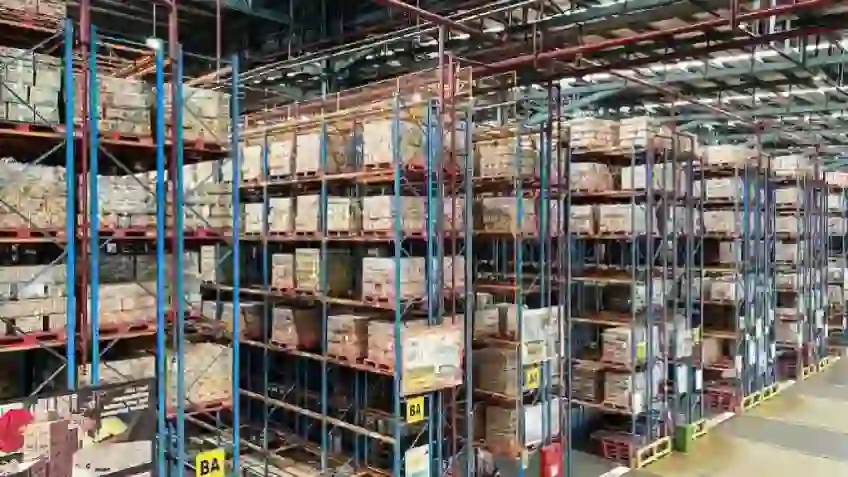
Warehouse rack labels are essential for efficient inventory management. They help you locate items quickly, reduce errors, and enhance warehouse workflow. This guide will explore different types of warehouse rack labels and how to choose the best warehouse rack label options for your needs.
Key Takeaways
- Warehouse rack labels are essential for improving inventory visibility and accuracy, which streamlines operations and reduces labor costs.
- Choosing the right type of labels, such as barcodes, magnetic labels, or pallet labels, is crucial for efficient inventory management based on your warehouse layout and needs.
- Implementing a robust labeling system with strategic label placement and maintaining label quality ensures easy identification and enhances overall warehouse efficiency.
Understanding Warehouse Rack Labels
Warehouse rack labels are much more than stickers—they are essential tools for efficient inventory management. These labels are typically attached directly to racks, offering visual cues that simplify the location and identification of items. By doing so, they help warehouse staff streamline operations, reduce errors, and boost productivity.
One of the main functions of rack labels is to provide important information about the location, contents, and ownership of items stored on warehouse shelves. This enhances visibility into inventory and facilitates the movement and organization of products throughout the warehouse.
Key Benefits of Warehouse Rack Labels:
- Reduced Labor Costs: A well-implemented labeling system optimizes picking and packing routes, improving workflow and reducing the time it takes for staff to locate items.
- Accurate Inventory Tracking: Clear labels minimize the risk of misplaced or lost items, which is especially important in large or high-volume warehouses.
- Improved Space Organization: By clearly marking each rack and shelf, labels help maintain a well-organized warehouse, making product identification and retrieval faster and more efficient.
By incorporating warehouse rack labels into your inventory management strategy, you’ll foster a more efficient, organized, and cost-effective environment.
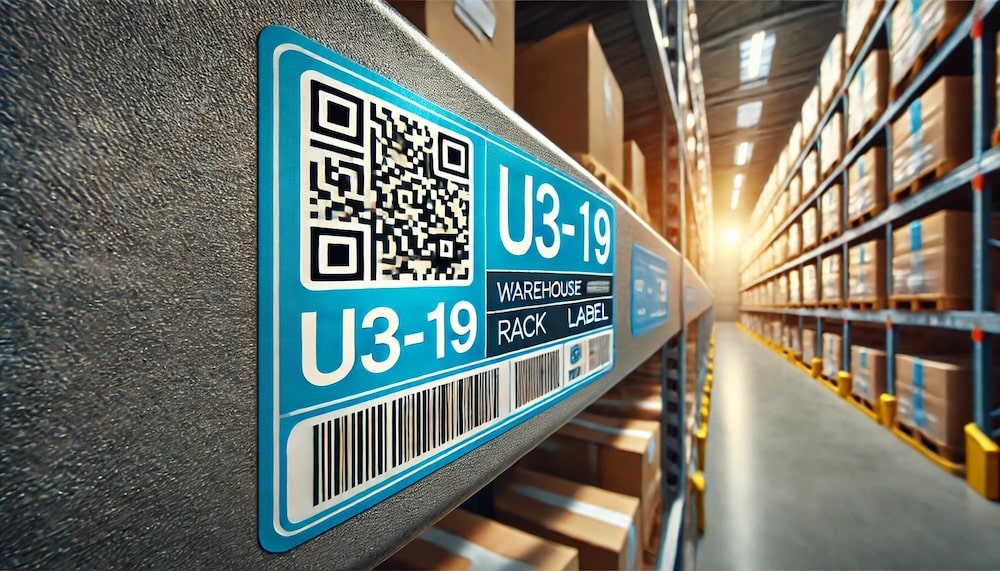
Types of Warehouse Rack Labels
Choosing the right type of warehouse rack labels is crucial for efficient inventory management. These labels come in various formats, each designed for different purposes based on your warehouse’s layout and inventory needs. Standard rack labels typically include key information such as SKUs, product names, and expiration dates to help employees quickly locate and manage items.
The best label type for your warehouse will depend on factors like the size of the facility, the types of goods stored, and how frequently your layout changes. For example, larger warehouses with dynamic inventories might benefit from barcode labels, while smaller facilities with frequent reconfigurations might find magnetic labels more practical. Let’s explore the different types of labels:
Barcode Labels
Barcode labels are a common choice in modern warehouses because they enable quick and accurate identification of items. There are two main types:
- 1D Barcodes: These are the traditional linear barcodes found on most packages. They can be scanned quickly and are often linked to dynamic databases that provide real-time updates on inventory.
- 2D Barcodes: These barcodes have a higher storage capacity and can hold more information, making them useful for complex inventory systems. The multi-level design also allows for more accurate scanning, especially in larger warehouses.
Innovations like SideScan 45 labels are specifically designed to improve scanning accuracy and reduce errors, making barcode labels an excellent choice for large-scale inventory management.
Magnetic Labels
Magnetic labels are ideal for warehouses with flexible layouts. They can be easily moved or adjusted as inventory locations change, offering adaptability without the hassle of leaving sticky residue behind. This makes them perfect for environments where the location of products is frequently updated, ensuring that your labeling system stays organized and efficient.
Pallet Labels
Pallet labels are designed to be applied directly to pallets for easy identification. These labels often combine human-readable text with symbols, ensuring clear and accurate communication for warehouse workers. Additionally, arrows and level indicators (numbers or letters) on pallet labels make it easy to place and retrieve pallets correctly, further enhancing warehouse efficiency.
Choosing the Right Label Material
Selecting the appropriate label material is essential for ensuring that warehouse labels remain durable and legible over time. Labels in a warehouse setting must withstand frequent handling, varying environmental conditions, and potential exposure to harsh elements like chemicals, moisture, or extreme temperatures. The longevity and readability of your labels depend on choosing materials that can endure these conditions.
Here are some factors to consider when selecting label materials:
- Temperature Resistance: In cold storage areas, you’ll need labels that can perform effectively in extremely low temperatures without losing their adhesive quality or readability. On the other hand, heat-resistant labels are necessary for warehouses operating in high-temperature environments.
- Moisture and Chemical Resistance: Waterproof labels are crucial for warehouses exposed to high humidity or chemicals. These labels ensure that the printed information remains clear and readable, even in challenging conditions.
- Durable Materials: Labels made from materials like vinyl and polypropylene are favored in warehouses for their ability to withstand wear and tear, resist damage, and maintain clarity. These materials are commonly used in environments where the labels need to last through frequent handling and rough conditions.
By selecting the right label material based on your warehouse’s environmental conditions, you’ll ensure that your labels stay intact, readable, and functional for as long as needed. This leads to better inventory management, reduced errors, and a more efficient warehouse operation overall.
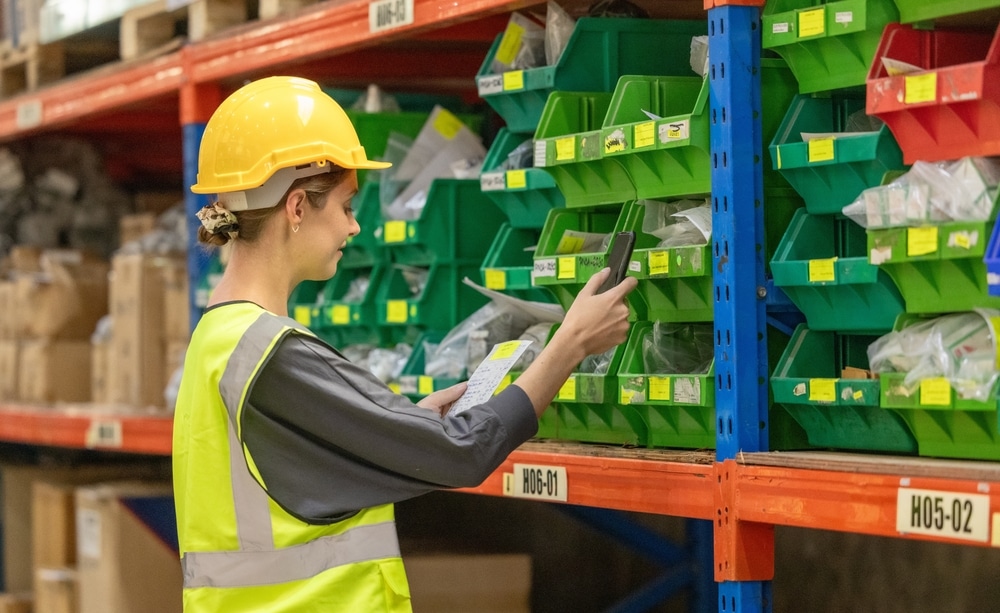
Best Practices for Label Placement
Strategic placement of warehouse labels is key to improving visibility, accessibility, and workflow efficiency. Properly placed labels ensure that they can be easily seen and scanned by both workers and devices, reducing time spent locating items and minimizing errors.
Here are some best practices for label placement:
- Visibility: Labels should be positioned where they are easily visible, such as near the top of shelves or at the end of aisles. This placement allows workers to quickly locate and scan items without unnecessary movement.
- Durability: Place labels in areas that are less prone to damage from frequent handling or warehouse machinery. Keeping labels out of high-traffic zones reduces the risk of them getting torn or worn down over time.
- Color Coding: Using color-coded labels is an effective way to categorize items visually. Assigning specific colors to different product categories or zones within the warehouse can further enhance organization and speed up the identification process.
- Consistency: Establish a consistent labeling system that uses the same placement rules across your warehouse. Whether you’re labeling racks, shelves, or pallets, uniformity in label placement helps streamline operations and reduces confusion among staff.
By following these best practices, you’ll ensure that your warehouse labeling system is efficient, reliable, and easy to maintain. This ultimately leads to faster workflows and fewer errors in a busy warehouse environment.
Implementing a Warehouse Rack Labeling System
Implementing a successful warehouse rack labeling system requires careful planning and execution. This process ensures that the labels effectively support inventory management and warehouse operations. Here’s a step-by-step guide to help you implement a robust labeling system:
- Define Objectives: Begin by identifying the goals of your labeling system. Consider factors such as improving picking accuracy, reducing search time, and maintaining real-time inventory tracking. Understanding your warehouse’s specific needs will guide the type of labels and placement strategies required.
- Assess the Environment: Evaluate the operating conditions of your warehouse. Factors like temperature, humidity, and the types of goods being stored all influence the label material and design. You’ll also need to assess the types of scanners used, scanning distances, and the required durability of the labels.
- Choose the Right Label Types: Based on your assessment, decide whether barcode, magnetic, pallet, or a combination of labels is most appropriate for your warehouse layout and workflow. Select materials that can withstand your warehouse’s environment and handling demands.
- Print and Apply Labels: Once the label types and materials are selected, the next step is to print them and apply them to designated areas in the warehouse. Ensure labels are placed in optimal locations for visibility and durability, as outlined in the label placement best practices.
- Maintain Label Quality: Implement a system for regularly checking labels for wear and tear, especially in high-traffic areas. This ensures that labels remain readable and functional. Damaged labels should be replaced promptly to avoid any disruptions in inventory tracking.
By carefully planning and implementing a warehouse rack labeling system, you can improve operational efficiency and reduce errors.
Planning Your Labeling Strategy
Effective warehouse labeling starts with a well-thought-out strategy. Before implementing your system, it’s essential to evaluate the warehouse layout, inventory turnover, and the types of goods being stored. A comprehensive labeling strategy takes these factors into account to ensure the system is tailored to your warehouse’s specific needs.
Consider the following when planning your strategy:
- Warehouse Layout: Map out your warehouse to identify the best label locations based on traffic flow, product accessibility, and storage methods. High-traffic areas may need more durable labels, while less-used sections could benefit from simpler label designs.
- Inventory Characteristics: Different types of goods may require specific labeling solutions. For instance, perishables might need expiration dates prominently displayed, while high-value items may need more detailed tracking information.
- Flexibility: Plan for potential changes in warehouse layout or product lines. Flexible solutions, such as magnetic labels or easily replaceable barcode labels, allow your labeling system to adapt without major disruptions.
By thoroughly assessing these elements, you’ll create a labeling system that supports efficient inventory management and minimizes downtime during future changes.
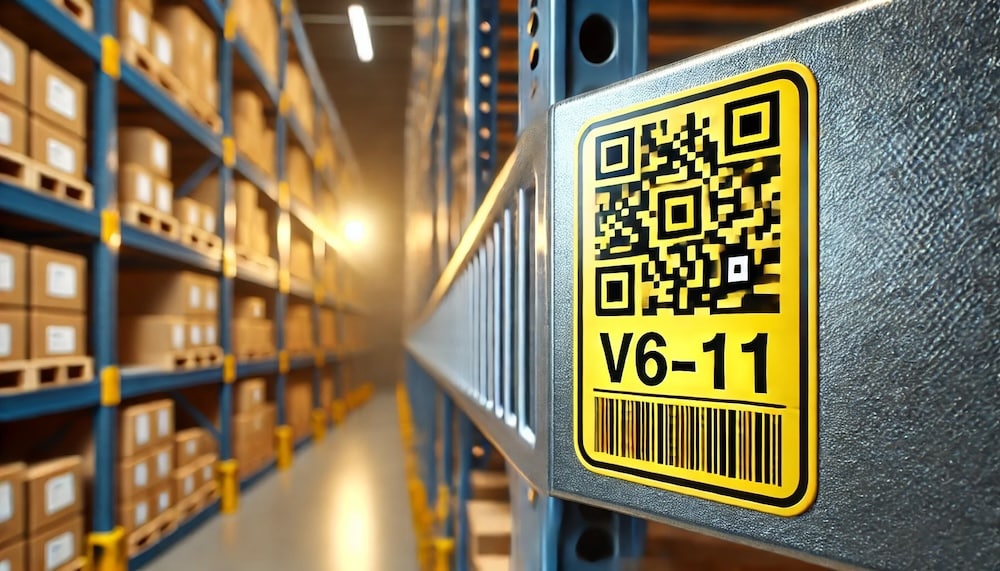
Applying and Maintaining Labels
Applying and maintaining your warehouse rack labels is an ongoing process that ensures the system continues to function smoothly over time. Here are some tips for ensuring your labels remain effective:
- Proper Application: Ensure that labels are applied in clean, accessible areas where they won’t be obstructed by inventory or warehouse equipment. This reduces the chances of labels becoming damaged or illegible.
- Regular Maintenance: Periodically inspect labels for wear, fading, or damage, especially in high-traffic zones. Magnetic labels offer a great solution for ease of replacement, as they can be quickly moved or updated without leaving sticky residue.
- Automation for Efficiency: Consider using automated label printing systems to streamline the application process. Automation eliminates the need for manual data entry, ensuring consistency and accuracy in label creation.
By maintaining your labels and updating them as needed, you’ll ensure that your warehouse continues to benefit from an organized and efficient labeling system.
Benefits of Effective Warehouse Rack Labeling
A well-implemented warehouse rack labeling system offers numerous benefits that directly impact the efficiency, accuracy, and overall productivity of your inventory management process. Here are some of the key advantages:
- Enhanced Inventory Control: Clear and consistent labels allow for real-time tracking of stock levels, reducing the likelihood of discrepancies and helping you maintain accurate inventory records. This tight control minimizes the risk of overstocking or running out of essential items.
- Reduced Picking Errors: Properly labeled racks make it easier for employees to locate items, reducing the chances of picking the wrong product. This improves order accuracy and speeds up the fulfillment process, leading to better customer satisfaction.
- Increased Productivity: By minimizing the time spent searching for products, your team can work more efficiently. A well-organized labeling system streamlines warehouse operations, allowing workers to complete tasks faster and with fewer mistakes.
- Improved Safety: Labels not only help with organization but can also mark hazardous areas or sensitive materials, promoting a safer working environment. By clearly identifying the location and contents of each rack, you can reduce the risk of accidents in the warehouse.
- Seamless Integration with Warehouse Management Systems (WMS): Integrating your labeling system with a WMS enables real-time updates on inventory levels, making it easier to manage stock and prevent errors. This integration further enhances workflow efficiency by providing accurate data for better decision-making.
By investing in a comprehensive labeling strategy, you can achieve better operational efficiency and long-term success.
Advanced Labeling Techniques
While standard labeling methods are effective, incorporating advanced labeling techniques can take your warehouse operations to the next level by improving efficiency and accuracy even further. One such technique is serpentine labeling.
Serpentine Labeling
This method involves arranging labels in a winding, ‘S’ shape pattern across racks. Instead of following a straight-line sequence, serpentine labeling alternates the order of labels from one row to the next. This pattern allows workers to move smoothly through aisles, reducing the time spent searching for items and streamlining the picking process. By providing a clear, easy-to-follow sequence, serpentine labeling minimizes confusion and boosts overall efficiency.
Multi-Level Labeling
In warehouses with tall racks, multi-level labeling ensures that each level of the rack is clearly identified, helping workers locate items quickly across different vertical tiers. This is especially useful in warehouses with dense or high shelving, where identifying the correct level is as important as finding the right section.
Incorporating these advanced techniques into your labeling system enhances organization and workflow, helping you get the most out of your warehouse space and increasing operational efficiency.
Leveraging Technology for Labeling
In today’s fast-paced warehouse environments, technology plays a vital role in enhancing the efficiency and accuracy of labeling systems. By integrating modern labeling technologies, you can streamline operations, reduce errors, and improve overall inventory management.
Automated Print-and-Apply Systems
One of the most effective technologies for labeling is the automated print-and-apply system. This system eliminates the need for manual label application, ensuring labels are printed accurately and applied consistently to the correct locations. By automating the process, warehouses can significantly reduce labeling errors and increase the speed of label placement.
Real-Time Data Integration
Modern labeling systems can also be integrated with your warehouse management system (WMS), allowing for real-time data updates. This means that as soon as an item is scanned or moved, the system updates inventory levels, reducing discrepancies and providing an up-to-date view of stock. Real-time visibility enhances decision-making and ensures that inventory is always accurate.
Mobile Scanning Solutions
Mobile scanning devices further enhance the labeling process by making it easy for workers to locate items and confirm their position in the warehouse. These devices allow for quick scanning of barcode and RFID labels, reducing the time spent searching for products and ensuring that the correct items are retrieved every time.
Safety and Compliance
Technology-driven labeling systems can also enhance warehouse safety by clearly marking hazardous materials or areas. Automated systems can ensure compliance with regulatory requirements by applying the correct labels to items that require special handling or identification.
By leveraging these technologies, you can optimize your warehouse operations, reduce human error, and maintain a higher level of efficiency and safety.
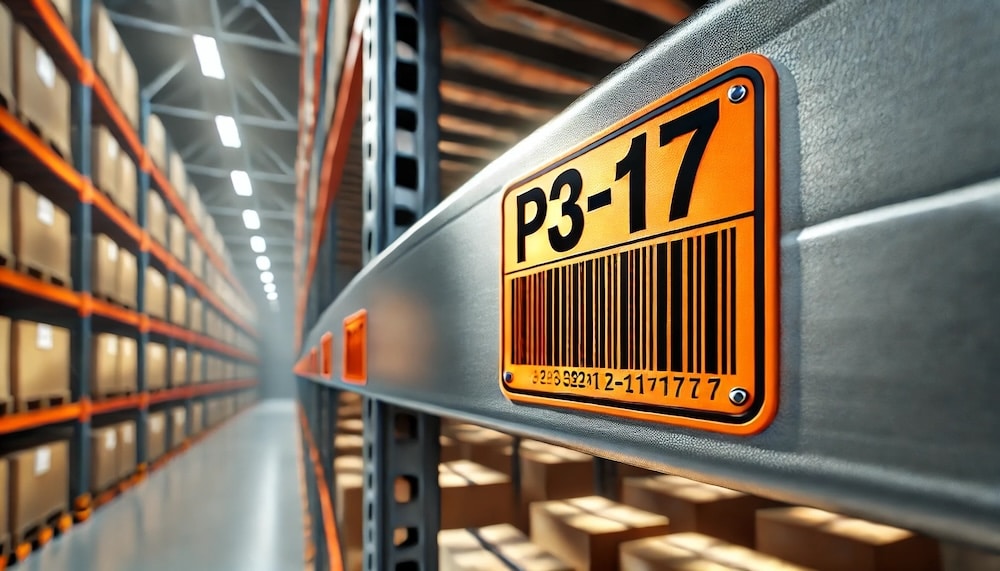
Tips for Making Labels Visible and Easy to Read
Ensuring that warehouse labels are highly visible and easy to read is critical for smooth operations. When labels are clearly displayed, workers can quickly locate and scan items, reducing errors and boosting productivity. Here are some tips to help you create labels that are both noticeable and legible:
- Use Bold, Bright Colors: Labels printed in bright colors, such as yellow, orange, or green, catch the eye and make it easier for warehouse staff to identify items quickly. Consider using contrasting colors between the label background and text for even greater visibility.
- Opt for Simple, Legible Fonts: Avoid overly decorative fonts that can be hard to read from a distance. Instead, choose clean, bold fonts that are easy to read at a glance. Font size also matters—ensure that your text is large enough to be seen from the average distance workers will be scanning from.
- Strategic Label Placement: Placing labels at eye level or slightly higher on racks or shelves ensures that they are easily spotted. Labels at the end of aisles or on the upper edges of shelves are particularly effective for quick identification.
- Consistent Label Design: A consistent design across all labels makes it easier for workers to understand the information at a glance. Stick to the same format for all labels, including font style, size, and placement of key details like SKUs, product names, and barcodes.
By following these tips, you’ll create a labeling system that enhances the efficiency and accuracy of your warehouse operations, reducing search time and improving overall workflow.
Summary
Warehouse rack labeling is a critical component of efficient inventory management, offering significant benefits such as improved accuracy, reduced errors, and increased productivity. By selecting the right label types, materials, and placement strategies, you can streamline your warehouse operations and create a more organized, efficient environment. Additionally, leveraging advanced labeling techniques and modern technologies can further enhance workflow and ensure real-time inventory tracking.
Looking to improve your warehouse efficiency? Contact us at Logimax to learn how our WMS solutions can help your business implement an effective labeling system and optimize your inventory management. Let us support your warehouse in achieving greater accuracy and productivity.
Frequently Asked Questions
What are the main types of warehouse rack labels?
The main types of warehouse rack labels include barcode labels, magnetic labels, and pallet labels. Each type is designed to meet specific inventory needs and warehouse layouts, helping streamline operations and improve efficiency.
How do barcode labels improve inventory management?
Barcode labels allow for quick and precise item identification, reducing errors and streamlining the tracking process. By linking to dynamic databases, barcode labels ensure real-time updates on inventory levels, improving accuracy and workflow.
Why is choosing the right label material important?
Choosing the right label material is essential for durability, especially in tough warehouse environments. Labels need to withstand factors like temperature, humidity, and frequent handling. Durable materials, such as vinyl or polypropylene, ensure labels remain legible and effective over time.
What are the benefits of effective warehouse rack labeling?
Effective warehouse rack labeling enhances inventory control, reduces picking errors, improves productivity, and increases safety. Additionally, integrating labeling systems with warehouse management software allows for real-time visibility, boosting overall efficiency.
How can technology enhance warehouse labeling?
Technology enhances warehouse labeling by automating the printing and application process, ensuring accuracy and consistency. Modern solutions, such as automated print-and-apply systems and mobile scanning devices, streamline operations and improve inventory management, while also ensuring compliance with safety regulations.


